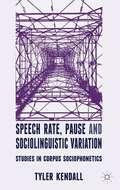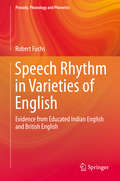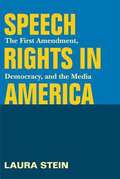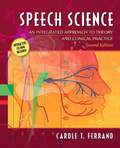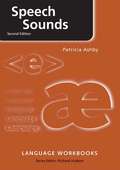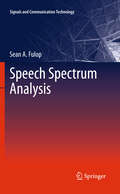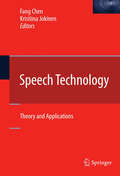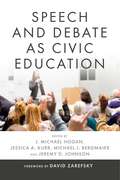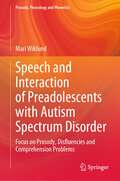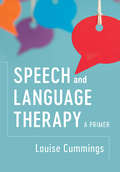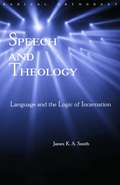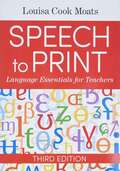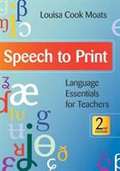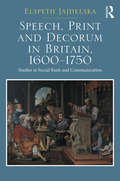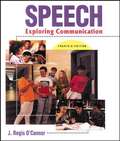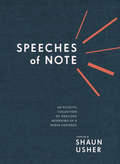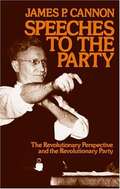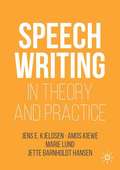- Table View
- List View
Speech Rate, Pause, and Sociolinguistic Variation
by Tyler KendallThis book provides a fascinating account of the psycholinguistic and social factors behind variation in speech timing in US English. With detailed discussions of its methods and data, it also acts as a valuable model for conducting corpus (socio)phonetic research.
Speech Rhythm in Learner and Second Language Varieties of English (Prosody, Phonology and Phonetics)
by Robert FuchsThis book presents cutting-edge research on the production and perception of speech rhythm by speakers of English in countries where it is used as a foreign language or an institutionalised second language (also sometimes known as the Expanding and Outer Circles). It contributes to a better understanding of speech rhythm, which has long been recognised as an important supra-segmental category of speech, focusing on its relevance in World Englishes, Second Language Acquisition and learner varieties of English, as well as the sociolinguistic and perceptual significance of this phonological variable.
Speech Rhythm in Varieties of English
by Robert FuchsThis book addresses the question whether Educated Indian English is more syllable-timed than British English from two standpoints: production and perception. Many post-colonial varieties of English, which are mostly spoken as a second language in countries such as India, Nigeria and the Philippines, are thought to have a syllable-timed rhythm, whereas first language varieties such as British English are characterized as being stress-timed. While previous studies mostly relied on a single acoustic correlate of speech rhythm, usually duration, the author proposes a multidimensional approach to the production of speech rhythm that takes into account various acoustic correlates. The results reveal that the two varieties differ with regard to a number of dimensions, such as duration, sonority, intensity, loudness, pitch and glottal stop insertion. The second part of the study addresses the question whether the difference in speech rhythm between Indian and British English is perceptually relevant, based on intelligibility and dialect discrimination experiments. The results reveal that speakers generally find the rhythm of their own variety more intelligible and that listeners can identify which variety a speaker is using on the basis of differences in speech rhythm.
Speech Rights in America: The First Amendment, Democracy, and the Media
by Laura SteinThe First Amendment is the principle guarantor of speech rights in the United States, but the Supreme Court's interpretations of it often privilege the interests of media owners over those of the broader citizenry. In Speech Rights in America, Laura Stein argues that such rulings alienate citizens from their rights, corrupt the essential workings of democracy, and prevent the First Amendment from performing its critical role as a protector of free speech. Drawing on the best of the liberal democratic tradition, Stein demonstrates that there is a significant gap between First Amendment law and the speech rights necessary to democratic communication, and proposes an alternative set of principles to guide future judicial, legislative, and cultural policy on old and new media.
Speech Science: An Integrated Approach to Theory and Clinical Practice (2nd edition)
by Carole T. FerrandTo demystify a topic that she has found often intimidates students, Ferrand (speech-language-hearing sciences, Hostra U.) breaks the material into explicitly linked units. Taking a systems approach, the author relates scientific concepts to human communicative behavior and clinical "mis" behavior. In addition to covering the standard topics of the nature of sound, the physiological systems involved, models and theories of speech production and perception, and clinical applications, she takes into account the impact on the field of technological advances. Includes review exercises, an extensive glossary, and an appendix of symbols for consonants and vowels. Annotation c. Book News, Inc., Portland, OR (book news. com)
Speech Sounds
by Patricia AshbySpeech Sounds: * helps develop the fundamental skills of the phonetician * investigates the various aspects involved in the production of speech sounds * uses data-based material to reinforce each new concept * includes examples from a wide range of languages * provides dozens of exercises with solutions and cross-references * can complement existing course or textbook material. The second edition of Speech Sounds has been revised and updated throughout and includes new examples and exercises, a new appendix giving information on career prospects; and a fully updated further reading section.
Speech Spectrum Analysis
by Sean A. FulopThe accurate determination of the speech spectrum, particularly for short frames, is commonly pursued in diverse areas including speech processing, recognition, and acoustic phonetics. With this book the author makes the subject of spectrum analysis understandable to a wide audience, including those with a solid background in general signal processing and those without such background. In keeping with these goals, this is not a book that replaces or attempts to cover the material found in a general signal processing textbook. Some essential signal processing concepts are presented in the first chapter, but even there the concepts are presented in a generally understandable fashion as far as is possible. Throughout the book, the focus is on applications to speech analysis; mathematical theory is provided for completeness, but these developments are set off in boxes for the benefit of those readers with sufficient background. Other readers may proceed through the main text, where the key results and applications will be presented in general heuristic terms, and illustrated with software routines and practical "show-and-tell" discussions of the results. At some points, the book refers to and uses the implementations in the Praat speech analysis software package, which has the advantages that it is used by many scientists around the world, and it is free and open source software. At other points, special software routines have been developed and made available to complement the book, and these are provided in the Matlab programming language. If the reader has the basic Matlab package, he/she will be able to immediately implement the programs in that platform---no extra "toolboxes" are required.
Speech Technology: Theory and Applications (Wiley Series In Agent Technology Ser. #11)
by Kristiina Jokinen Fang ChenThis book gives an overview of the research and application of speech technologies in different areas. One of the special characteristics of the book is that the authors take a broad view of the multiple research areas and take the multidisciplinary approach to the topics. One of the goals in this book is to emphasize the application. User experience, human factors and usability issues are the focus in this book.
Speech and Debate as Civic Education (Rhetoric and Democratic Deliberation #15)
by J. Michael Hogan Jessica A. Kurr Michael J. Bergmaier Jeremy D. JohnsonIn an era increasingly marked by polarized and unproductive political debates, this volume makes the case for a renewed emphasis on teaching speech and debate, both in and outside of the classroom.Speech and debate education leads students to better understand their First Amendment rights and the power of speaking. It teaches them to work together collaboratively to solve problems, and it encourages critical thinking, reasoned and fact-based argumentation, and respect for differing viewpoints in our increasingly diverse and global society. Highlighting the need for more emphasis on the ethics and skills of democratic deliberation, the contributors to this volume—leading scholars, teachers, and coaches in speech and debate programs around the country—offer new ideas for reinvigorating curricular and co-curricular speech and debate by recovering and reinventing their historical mission as civic education.Combining historical case studies, theoretical reflections, and reports on programs that utilize rhetorical pedagogies to educate for citizenship, Speech and Debate as Civic Education is a first-of-its-kind collection of the best ideas for reinventing and revitalizing the civic mission of speech and debate for a new generation of students.In addition to the editors, the contributors to this volume include Jenn Anderson, Michael D. Bartanen, Ann Crigler, Sara A. Mehltretter Drury, David A. Frank, G. Thomas Goodnight, Ronald Walter Greene, Taylor W. Hahn, Darrin Hicks, Edward A. Hinck, Jin Huang, Una Kimokeo-Goes, Rebecca A. Kuehl, Lorand Laskai, Tim Lewis, Robert S. Littlefield, Allan D. Louden, Paul E. Mabrey III, Jamie McKown, Gordon R. Mitchell, Catherine H. Palczewski, Angela G. Ray, Robert C. Rowland, Minhee Son, Sarah Stone Watt, Melissa Maxcy Wade, David Weeks, Carly S. Woods, and David Zarefsky.
Speech and Debate as Civic Education (Rhetoric and Democratic Deliberation)
by David Zarefsky Jessica A. Kurr Michael J. Bergmaier Jeremy D. Johnson Michael HoganIn an era increasingly marked by polarized and unproductive political debates, this volume makes the case for a renewed emphasis on teaching speech and debate, both in and outside of the classroom.Speech and debate education leads students to better understand their First Amendment rights and the power of speaking. It teaches them to work together collaboratively to solve problems, and it encourages critical thinking, reasoned and fact-based argumentation, and respect for differing viewpoints in our increasingly diverse and global society. Highlighting the need for more emphasis on the ethics and skills of democratic deliberation, the contributors to this volume—leading scholars, teachers, and coaches in speech and debate programs around the country—offer new ideas for reinvigorating curricular and co-curricular speech and debate by recovering and reinventing their historical mission as civic education.Combining historical case studies, theoretical reflections, and reports on programs that utilize rhetorical pedagogies to educate for citizenship, Speech and Debate as Civic Education is a first-of-its-kind collection of the best ideas for reinventing and revitalizing the civic mission of speech and debate for a new generation of students.In addition to the editors, the contributors to this volume include Jenn Anderson, Michael D. Bartanen, Ann Crigler, Sara A. Mehltretter Drury, David A. Frank, G. Thomas Goodnight, Ronald Walter Greene, Taylor W. Hahn, Darrin Hicks, Edward A. Hinck, Jin Huang, Una Kimokeo-Goes, Rebecca A. Kuehl, Lorand Laskai, Tim Lewis, Robert S. Littlefield, Allan D. Louden, Paul E. Mabrey III, Jamie McKown, Gordon R. Mitchell, Catherine H. Palczewski, Angela G. Ray, Robert C. Rowland, Minhee Son, Sarah Stone Watt, Melissa Maxcy Wade, David Weeks, Carly S. Woods, and David Zarefsky.
Speech and Interaction of Preadolescents with Autism Spectrum Disorder: Focus on Prosody, Disfluencies and Comprehension Problems (Prosody, Phonology and Phonetics)
by Mari WiklundThe book focuses on the interaction of persons with autism spectrum disorder (ASD). ASD is a neurobiological developmental disorder, characterized by problems with social interaction, over-sensitivity to sensory stimuli and restricted interest (APA 2013). Problems with social interaction being a core feature of ASD, there is a scientific and a societal need for a book focusing on this topic. The book approaches the interaction of persons with ASD from a new angle. Firstly, where most studies on ASD are based on data coming from experimental settings, this book is based on naturally occurring data coming from group therapy sessions where 11–13-year-old Finnish- and French-speaking boys with ASD talk with each other and with their therapists. Secondly, the book treats a variety of themes that have so far been studied much less than, for example, the pragmatic problems of persons with ASD. These themes include the following aspects: speech prosody (characteristic features, perception of atypicality by neurotypical listeners), disfluencies of speech (comparison with neurotypical controls), comprehension problems (role of prosody, role of disfluencies, other causes), gaze behavior (eye contact avoidance strategies, using gaze as a source of feedback) as well as therapists’ response strategies and teaching orientations. The book is intended for researchers working in the field of autism, professionals working with persons with ASD as well as for families of persons with ASD.
Speech and Language Therapy: A Primer
by Louise CummingsProviding a comprehensive introduction to speech and language therapy, this book introduces students to the linguistic, medical, scientific and psychological disciplines that lie at the foundation of this health profession. As well as examining foundational disciplines the volume also addresses professional issues in speech and language therapy and examines how therapists assess and treat clients with communication and swallowing disorders. The book makes extensive use of group exercises that allows SLT students opportunity for practice-based learning. It also includes multiple case studies to encourage discussion of assessment and intervention practices and end-of-chapter questions with complete answers to test knowledge and understanding. As well as providing a solid theoretical grounding in communication disorders, this volume will equip students with a range of professional skills, such as how to treat patients, how to diagnose and assess clients, how to help parents support children with communication disabilities, and how to assess the effectiveness of the various practices and methods used in intervention.
Speech and Silence in Contemporary Children’s Literature (Children's Literature and Culture)
by Danielle E. PriceSpeech and Silence in Contemporary Children’s Literature brings a fresh perspective to a central literary question— Who speaks?— by examining a variety of represented silences. These include children who do not speak, do not yet speak effectively, or speak on behalf of others. A rich and unexamined literary archive explores the problematics of children who are literally silent or metaphorically so because they cannot communicate effectively with adults or peers. This project centers children’s literature in the question of voice by considering disability, gender, race, and ecocriticism. Children’s literature rests on a paradox at the root of its own genre: it is produced by an adult author writing to a constructed idea of what children should be. By reading a range of contemporary children’s literature, this book scrutinizes how such texts narrate the child’s journey from communicative alterity to a place of empowered adult speech. Sometimes the child’s verbal enclosure enables privacy and resistance. At other times, silence is coerced or imposed or arises from bodily impairment. Children may act as intermediaries, speaking on behalf of species that cannot. Recently, we have seen children exercise their voices on the world stage and as authors. In all cases, the texts analyzed here reveal speech as a minefield to be traversed. Children who talk too much, too little, or with insufficient expertise pose problems to themselves and others. Implicitly and sometimes explicitly, they attempt to hold adults to account— inside and outside the text. Speech and Silence in Contemporary Children’s Literature addresses this underconceptualized subject in what will be an important text for scholars of children’s literature, childhood studies, English, disability studies, gender studies, race studies, ecopedagogy, and education.
Speech and Theology: Language and the Logic of Incarnation (Routledge Radical Orthodoxy)
by James K.A. SmithGod is infinite, but language finite; thus speech would seem to condemn Him to finitude. In speaking of God, would the theologian violate divine transcendence by reducing God to immanence, or choose, rather, to remain silent? At stake in this argument is a core problem of the conditions of divine revelation. How, in terms of language and the limitations of human understanding, can transcendence ever be made known? Does its very appearance not undermine its transcendence, its condition of unknowability?Speech and Theology posits that the paradigm for the encounter between the material and the divine, or the immanent and transcendent, is found in the Incarnation: God's voluntary self-immersion in the human world as an expression of His love for His creation. By this key act of grace, hinged upon Christs condescension to human finitude, philosophy acquires the means not simply to speak of perfection, which is to speak theologically, but to bridge the gap between word and thing in general sense.
Speech and the City: Multilingualism, Decoloniality and the Civic University
by Yaron MatrasThe Brexit debate has been accompanied by a rise in hostile attitudes to multilingualism. However, cities can provide an important counter-weight to political polarisation by forging civic identities that embrace diversity. In this timely book, Yaron Matras describes the emergence of a city language narrative that embraces and celebrates multilingualism and helps forge a civic identity. He critiques linguaphobic discourses at a national level that regard multilingualism as deficient citizenship. Drawing on his research in Manchester, he examines the 'multilingual utopia', looking at multilingual spaces across sectors in the city that support access, heritage, skills and celebration. The book explores the tensions between decolonial approaches that inspire activism for social justice and equality, and the neoliberal enterprise that appropriates diversity for reputational and profitability purposes, prompting critical reflection on calls for civic university engagement. It is essential reading for anyone concerned about ways to protect cultural pluralism in our society.
Speech for Effective Communication
by Rudolph F. VerderberSpeech For Effective Communication is divided into 6 units, which are further divided into 22 chapters. Unit 1, containing Chapters 1-5, presents basic speech communication skills. Chapter 1 introduces the field of speech communication. Chapters 2 and 3 acquaint you with the concepts of verbal and nonverbal communication. Chapter 4 covers the vocalization process, and Chapter 5 introduces listening skills. Unit 2, containing Chapters 6-8, presents interpersonal communication skills, including making introductions, giving and receiving directions, using the telephone, engaging in conversations, and taking part in job and college interviews. Unit 3, containing Chapters 9-13, presents public speaking skills. Chapters 9-11 cover speech preparation skills; Chapter 12 discusses diction and effective word choice; and Chapter 13 introduces methods and skills for delivering speeches. Unit 4, containing Chapters 14-16, applies the information presented in Unit 3 to the development of three basic kinds of speeches: informative speech, process speech, and persuasive speech. Unit 5, containing Chapters 17-19, presents group communication skills. Chapter 17 covers group discussion; Chapter 18 introduces debate; and Chapter 19 discusses parliamentary procedure. Unit 6, containing Chapters 20-22, presents the performing arts, including oral interpretation, theater, and radio and television. Following these chapters are an appendix of speeches, a glossary of vocabulary terms, and the index.
Speech for Today
by Brian Ashbaugh Beka HortonGood speech habits have a direct connection with success—success in school, in conversations and discussions, and in presentations. Knowing how to speak well may make the difference between success and failure. This handbook in speech training presents the art of everyday speech in a friendly, conversational style that you and your high schooler will love. Your teen will learn the fine points of giving a personal testimony and a devotional. He may even discover performance talent as he studies monologue, poetry interpretation, and storytelling. Many speaking exercises and selections for interpretation provide opportunities for practice and performance. Grades 11–12.
Speech to Print: Language Essentials for Teachers
by Louisa Cook MoatsFor two decades, Speech to Print has been a bestselling, widely adopted textbook on explicit, high-quality literacy instruction. Now the anticipated third edition is here, fully updated with ten years of new research, a complete package of supporting materials, and expanded guidance on the how of assessment and instruction in today's classrooms. <p><p>Filling a critical gap in teacher preparation courses, Speech to Print supplies K-12 educators with in-depth knowledge of the structure and function of language—fundamentals they need to deliver successful structured literacy instruction. Renowned literacy expert Louisa Cook Moats gives current and future teachers comprehensive, accurate, and accessible information on the underpinnings of language instruction, including: <p>•The history of the English language and its effect on spelling English phonology, including speech sounds and their distinctive features <p>•How print represents speech in English <p>•The morphological aspects of words <p>•Syntax and its instruction <p>•How meaning is conveyed with language <p><p>Through case studies, activities, recommended teaching principles, and close analysis of real-world student work samples, teachers will also receive invaluable insight into how their students should be taught. Ideal for use in preservice courses and in-service professional development sessions, this essential textbook will give educators the strong foundation they need to teach language and reading skills to students with and without disabilities.
Speech to Print: Language Essentials for Teachers
by Louisa MoatsOne of the most popular and influential reading textbooks of the past 10 years gets a comprehensive update in this highly anticipated second edition, straight from renowned NCTQ-recommended expert Louisa Moats. Updated meticulously with the very latest research, the new edition of this bestselling text helps elementary educators grasp the structure of written and spoken English, understand how children learn to read, and apply this foundational knowledge as they deliver explicit, high-quality literacy instruction. <P><P>With extensive updates and enhancements to every chapter, the new edition of Speech to Print fully prepares today's literacy educators to teach students with or without disabilities.
Speech, Print and Decorum in Britain, 1600--1750: Studies in Social Rank and Communication
by Elspeth JajdelskaFilling an important gap in the history of print and reading, Elspeth Jajdelska offers a new account of the changing relationship between speech, rank and writing from 1600 to 1750. Jajdelska draws on anthropological findings to shed light on the different ways that speech was understood to relate to writing across the period, bringing together status and speech, literary and verbal decorum, readership, the material text and performance. Jajdelska's ambitious array of sources includes letters, diaries, paratexts and genres from cookery books to philosophical discourses. She looks at authors ranging from John Donne to Jonathan Swift, alongside the writings of anonymous merchants, apothecaries and romance authors. Jajdelska argues that Renaissance readers were likely to approach written and printed documents less as utterances in their own right and more as representations of past speech or as scripts for future speech. In the latter part of the seventeenth century, however, some readers were treating books as proxies for the author's speech, rather than as representations of it. These adjustments in the way speech and print were understood had implications for changes in decorum as the inhibitions placed on lower-ranking authors in the Renaissance gave way to increasingly open social networks at the start of the eighteenth century. As a result, authors from the lower ranks could now publish on topics formerly reserved for the more privileged. While this apparently egalitarian development did not result in imagined communities that transcended class, readers of all ranks did encounter new models of reading and writing and were empowered to engage legitimately in the gentlemanly criticism that had once been the reserve of the cultural elites. Shortlisted for the European Society for the Study of English (ESSE) book prize 2018
Speech: Exploring Communication (4th edition)
by J. Regis O'ConnorSpeech: Exploring Communication was developed to build on existing skills in an "explain" and "do" approach. Every topic in speech is comprehensively covered and all lessons have been carefully developed to ensure student success.
Speeches of Note: An Eclectic Collection of Orations Deserving of a Wider Audience
by Shaun UsherFrom the author of the New York Times bestseller Letters of Note comes a collection of 75 of history's most interesting, profound, and sometimes unknown speeches from a range of scintillating personalities such as Frederick Douglass, Justin Trudeau, Albert Einstein, Meghan Markle, Barbara Jordan, and Ursula K. Le Guin. This thoughtfully curated and richly illustrated collection celebrates oratory old and new, highlighting speeches we know and admire, while also shining a light on profound drafts that were never delivered or have until now been forgotten. From George Bernard Shaw's warm and rousing toast to Albert Einstein in 1930 and the commencement address affectionately given to graduates at Long Island University by Kermit the Frog, to the chilling public announcement (that was thankfully never made) by President Richard Nixon should Neil Armstrong and Buzz Aldrin become stranded on the moon, Speeches of Note honors the words and ideas of some of history’s most provocative and inspiring personages.
Speeches to the Party: The Revolutionary Perspective and the Revolutionary Party
by James P. Cannon Al HansenWriting in the early 1950s, Cannon discusses how a proletarian party can resist the conservatizing pressures of the emerging capitalist expansion and anticommunist witch-hunt. He discusses Washington's failure to achieve its goals in the Korean War, why the rulers reined in McCarthyism, and how class-conscious workers under these conditions carried out effective union work and political activity to build a communist workers party. Includes: Notes, Appendices, Introduction
Speechwriting in Theory and Practice (Rhetoric, Politics and Society)
by Jens E. Kjeldsen Amos Kiewe Marie Lund Jette Barnholdt Hansen (Deceased)This book provides students, researchers, and practitioners of speechwriting with a unique insight in the theory, history, and practice of speechwriting. The combination of theory and practice with case studies from the United States and Europe makes this volume the first of its kind. The book offers an overview of the existing research and theory, analysing how speeches are written in political and public life, and paying attention to three central subjects of contemporary speechwriting: convincing characterization of the speaker, writing for the ear, and appealing with words to the eye. Chapters address the ethics and the functions of speechwriting in contemporary society and also deliver general instructions for the speechwriting process. This book is recommended reading for professional speechwriters wishing to expand their knowledge of the rhetorical and theoretical underpinnings of speechwriting, and enables students and aspiring speechwriters to gain an understanding of speechwriting as a profession.
Speechwriting in Theory and Practice (Rhetoric, Politics and Society)
by Jens E. Kjeldsen Amos Kiewe Marie Lund Jette Barnholdt HansenThis book provides students, researchers, and practitioners of speechwriting with a unique insight in the theory, history, and practice of speechwriting. The combination of theory and practice with case studies from the United States and Europe makes this volume the first of its kind. The book offers an overview of the existing research and theory, analysing how speeches are written in political and public life, and paying attention to three central subjects of contemporary speechwriting: convincing characterization of the speaker, writing for the ear, and appealing with words to the eye. Chapters address the ethics and the functions of speechwriting in contemporary society and also deliver general instructions for the speechwriting process. This book is recommended reading for professional speechwriters wishing to expand their knowledge of the rhetorical and theoretical underpinnings of speechwriting, and enables students and aspiring speechwriters to gain an understanding of speechwriting as a profession.
